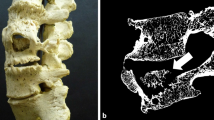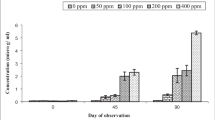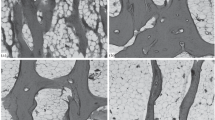Abstract
Various doses of alizarin red S, trypan blue, chlortetracycline and45Ca were injected into young male New Zealand white rabbits. The influence of these agents on bone growth was studied at the microscopic level by comparison with vital staining by lead acetate.
From evaluation of bone growth on the basis of the distance between the lead acetate lines,45Ca had no adverse effect; temporary inhibition of bone growth was the largest with alizarin red S and least with chlortetracycline. The higher the average level of alizarin red S, trypan blue and chlortetracycline the stronger was the inhibitory influence on bone growth. Alizarin red S at 100 mg/kg reduced the rate of bone growth and at 150 mg/kg caused complete cessation of bone growth. Trypan blue at 100 mg/kg and 50 mg/kg of chlortetracycline caused a decrease in bone formation and 350 mg/kg of trypan blue stopped osteogenetic activity. The retardation by chlortetracycline was quickly overcome but after alizarin red S and trypan blue, normal bone growth was regained slowly.
Résumé
Les auteurs ont injecté à de jeunes lapins blancs de Nouvelle-Zélande, mâles, des doses variables de: Rouge Alizarine S, bleu Trypan, Chlortetracycline ou Ca45.
Ils ont étudié l'influence de ces différents facteurs sur la croissance osseuse à l'échelle microscopique, en comparaison avec les résultats fournis par la méthode utilisant des colorants vitaux à base d'acétate de plomb.
Le45Ca s'est revelé sans effect.
Par contre les autres substances entraînent une inhibition temporaire de la croissance; celle-ci est la plus marquée après administration de Rouge Alizarine S et minimum avec la Chlortetracycline; elle est d'autant plus nette que la dose administrée est plus forte.
A la dose de 100 mg/kg le Rouge Alizarine S réduit seulement la croissance osseuse; celle-ci est stoppée par une dose de 150 mg/kg.
De même une dose de 50 mg/kg de Chlortetracycline ou de 100 mg/kg de Bleu Trypan ralentit la croissance osseuse; une dose de 350 mg/kg de Bleu Trypan bloque toute activité ostéogénique.
L'effet de la Chlortetracycline est très transitoire, celui des autres substances moins rapidement reversible.
Zusammenfassung
Verschiedene Dosen von Alizarinrot S, Trypanblau, Chlortetracyclin und45Ca wurden jungen, männlichen, weißen Neuseeländer-Kaninchen injiziert. Der Einfluß dieser Substanzen auf das Knochenwachstum wurde anhand der Bleiacetat-Vitalfärbung im mikroskopischen Präparat untersucht.
Vergleiche auf Grund des zwischen den Bleiacetat-Linien liegenden Abstandes zeigten, daß45Ca keine hemmende Wirkung auf das Knochenwachstum ausübt. Die stärkste temporäre Blockierung des Knochenwachstums wurde durch Alizarinrot S, die schwächste durch Chlortetracyclin hervorgerufen. Je höher die durchschnittlich gegebene Dosis Alizarinrot S, Trypanblau und Chlortetracyclin war, desto stärker machte sich deren hemmender Einfluß auf das Knochenwachstum bemerkbar. Bei einer Gabe von 100 mg/kg Alizarinrot S wurde das Knochenwachstum eingeschränkt, während 150 mg/kg einen kompletten Stillstand desselben bewirkten. Eine Dosis von 100 mg/kg Trypanblau und von 50 mg/kg Chlortetracyclin ließ die Knochenbildung abnehmen, während 350 mg/kg Trypanblau die osteogenetische Aktivität vollständig blockierten. Die Verzögerung des Knochenwachstums durch Chlortetracyclin war rasch überwunden, wogegen sich das normale Knochenwachstum nach Alizarinrot S- und Trypanblau-Gaben nur langsam wieder einstellte.
Similar content being viewed by others
References
Bevelander, G., L. Goldberg, andH. Nakahara: The effect of tetracycline on skeletal development in the larval sand dollar. Arch. oral. Biol.2, 127–131 (1960)a.
—,H. Nakahara, andG. K. Rolle: The effect of tetracycline on the development of the skeletal system of the chick embryo. Develop. Biol.2, 298–310 (1960b).
—,G. K. Rolle, andS. Q. Cohlan: The effect of the administration of tetracycline on the development of teeth. J. dent. Res.40, 1020–1024 (1961).
Cleall, J. F., R. E. Perkins, andJ. E. Gilda: Bone marking agents for the longitudinal study of growth in animals. Arch. oral Biol.9, 627–646 (1964).
Hong, Y. C., P. K.-J., Yen, andJ. H. Shaw: An analysis of the growth of the cranial vault in rabbits by vital staining with lead acetate. Calc. Tiss. Res. (submitted for publication).
Mori, H.: An analysis of the trypan blue stained tooth layer using lead acetate [Japanese]. J. Stomat. Ass.37, 1856–1867 (1959).
Okada, M., u.T. Mimura: Zur Physiologie und Pharmakologie der Hartgewebe. I. Mitt.: Eine Vitalfärbungsmethode mit Bleisalzen und ihre Anwendung bei den Untersuchungen über die rhythmische Streifenbildung der harten Zahngewebe. Jap. J. med. sci. Pharmacol.11, 166–170 (1938).
——: Zur Physiologie und Pharmakologie der Hartgewebe. III. Mitt.: Über die Genese der rhythmischen der harten Zahngewebe. Jap. J. med. Sci. Pharmacol.13, 92–95 (1940).
Paff, G. H., A. W. Angulo, andF. C. Eksterowicz: The zone of mineralization and the action of alizarin in preventing its appearance in bones growing in tissue culture. Anat. Rec.110, 129–137 (1951).
—, andF. C. Eksterowicz: The selective stoppage of bone growth in tissue culture. Anat. Rec.108, 45–55 (1950).
Riö, A.: The cranial bone growth of rabbits [Japanese]. Ochanomizu Gakkai Zasshi3, 98–114 (1955).
Schour, I., M. M. Hoffman, B. G. Sarnat, andM. B. Engel: Vital staining of growing bones and teeth with alizarin red S. J. dent. Res.20, 411–418 (1941).
Westerhoff, W. R.: Vital staining with the use of lead acetate. M. S. Thesis University of Illinois 1962.
Zak, D. F.: Lead acetate vital staining as a means of demonstrating bone growth patterns. M. S. Thesis University of Illinois 1963.
Author information
Authors and Affiliations
Additional information
Work supported in part by U.S. Public Health Service research grant DE-00373 and career award 5-K6-DE-22,634.
Fellowship FO 5-TW-1029.
Rights and permissions
About this article
Cite this article
Hong, Y.C., Yen, P.K.J. & Shaw, J.H. Microscopic evaluation of the effects of some vital staining agents on growing bone in rabbits. Calc. Tis Res. 2, 286–295 (1968). https://doi.org/10.1007/BF02279216
Received:
Issue Date:
DOI: https://doi.org/10.1007/BF02279216




